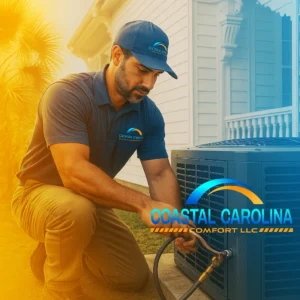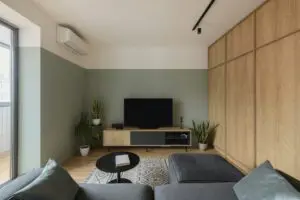Late summer in Charleston doesn’t usually give your home much of a break from the heat, and it definitely doesn’t ease up on the humidity. By August, daily thunderstorms and thick steam from the marshy Lowcountry air often stick around, leaving homes heavier with moisture. When humidity builds up indoors, it messes with your comfort and invites a whole list of other problems. Your air might feel sticky, your sheets might feel damp, and even the furniture might seem like it’s holding in moisture.
High humidity inside isn’t just uncomfortable. It can also take a toll on your home’s structure, air quality, and even your health. When too much moisture lingers indoors, it can damage materials, lead to mold, and make allergies worse. That’s why it’s helpful to know what actually causes high indoor humidity in the first place, especially in places like Charleston where it’s a regular part of the weather through late summer.
What Causes High Indoor Humidity in Late Summer?
There’s more than one reason you might notice sticky air and stuffy rooms during this time of year. Some houses handle humidity better than others based on age, layout, airflow, and insulation. Charleston’s steamy afternoons don’t help either, especially when they come back day after day.
Here are some common reasons humidity creeps into indoor spaces:
1. Climate and Weather Patterns
Charleston’s subtropical climate means hot temperatures, nearly daily thunderstorms, and lots of moisture in the air. Even on days with no rain, the air outside is likely already holding a high level of moisture. When windows or doors are left open, or if there are leaks around them, all that outdoor humidity easily makes its way inside.
2. Poor Ventilation
Homes that don’t circulate fresh air well trap moisture in kitchens, bathrooms, and laundry rooms. If your exhaust fans don’t work well or you skip using your ventilation system, steam from daily routines builds up quickly. That moisture doesn’t just disappear, it clings to walls, ceilings, and anything else it can reach.
3. Leaks and Weak Insulation
Small gaps in your attic, crawl space, or around your windows can allow humid air from outside to seep in. Insulation that’s either too thin or installed incorrectly also lets the outside conditions influence what’s going on inside. And since cooler air can’t push moisture out as effectively, your home acts like a sponge over time.
4. Everyday Activities
Long showers, lots of cooking, and even drying clothes inside can fill the air with water vapor. If there’s no airflow to carry it out, all that moisture just builds up and hangs around. It’s easy to overlook, but routine tasks add quite a bit to indoor humidity levels.
Take one Mount Pleasant homeowner, for example, who came home every day to condensation on the inside of her windows. She thought it was just the heat from the sun hitting the glass. After finally having it checked out, it turned out her bathroom exhaust fan had stopped working months earlier, and a slow leak near her laundry room was steadily feeding extra moisture into the air. Simple causes can stack up fast.
Knowing what leads to high humidity is the first step to taking control of it in your home. Once you identify the likely source, or sources, you can start finding real solutions that improve your comfort now and protect your space through the rest of Charleston’s humid season.
Effects of High Indoor Humidity
After identifying the culprits behind high humidity, it’s time to look at what happens when moisture levels rise. The effects can vary from mild discomfort to more serious consequences for both your living space and your health.
One of the most obvious issues is discomfort. High humidity can make the air feel warmer than it actually is, leaving you feeling sticky and restless. It often leads to tough nights as your sheets cling to you and the air feels too warm for sleeping.
Another real concern is the growth of mold and mildew. These unwelcome guests thrive in damp conditions, and they can multiply quickly in areas with high humidity. Mold doesn’t just ruin walls and furniture, it can also trigger breathing problems and worsen allergy symptoms. You might notice dark patches around windows or under sinks, which could be signs of bigger air quality problems.
Your home and belongings can also suffer. Too much moisture can warp wood flooring, peel paint, and damage artwork, books, and even electronics. That beautiful quilt or wooden dresser? High humidity might shorten their lifespan without you even noticing until it’s too late.
On top of that, indoor humidity affects your well-being. Breathing in moist air filled with allergens and mold spores can cause coughing, sneezing, wheezing, and sinus discomfort. For people who deal with asthma, that sticky air can make symptoms flare up even more. Humidity affects more than comfort—it’s something that can drag down your day-to-day quality of life.
How to Manage High Indoor Humidity
Once you understand the effects of high humidity, taking action becomes more important. Here are a few proven ways to help reduce indoor moisture and improve your air quality.
1. Use of Dehumidifiers
Dehumidifiers help pull moisture from the air, keeping humidity levels in a more comfortable range. They’re especially helpful in basements, bathrooms, and other places where sweating walls or musty smells might be an issue. Even running one occasionally during Charleston’s wettest weeks can make a difference.
2. Maintenance of HVAC System
A well-maintained HVAC system goes a long way. Air conditioners are designed to lower humidity as they cool the air. But if your unit is clogged or isn’t working right, it may struggle to remove moisture. Scheduling regular checkups helps your HVAC system do its job better year-round.
3. Improving Ventilation
Good ventilation can stop humidity before it becomes a problem. Well-placed exhaust fans in bathrooms and kitchens push out steamy air from showers and cooking. You can also boost ventilation by letting outdoor air in during drier hours of the day or adding vents in stuffy rooms. Fresh air helps cycle the dampness out.
4. Air Duct Repair and Insulation
When your air ducts have gaps, holes, or poor insulation, they can bring in warm, humid air from crawl spaces, attics, or outdoors. Sealing those ducts and updating older insulation keeps that damp air out and helps evenly cool your home. Fixing this issue can be one of the most effective ways to manage moisture during the August heat.
Protecting Your Charleston Home from Humidity
Managing indoor humidity is about more than feeling cool. It’s about protecting your belongings, breathing easier, and making sure your home lasts through the Lowcountry heat. Homes in Charleston face real challenges because of the regular storms and thick air that come with late summer, but with the right steps, you can take control.
Using dehumidifiers, getting HVAC checkups, upgrading vents, and sealing air ducts are all real solutions that help lower indoor moisture. Even small changes can bring big improvements to how your home feels. And since high humidity can build up quickly and quietly, staying on top of it keeps problems like mold or damaged fixtures from creeping in.
When the weather won’t let up, your house should still be a place where the air is calm, dry, and comfortable. With a little help and some smart updates, you can keep things feeling fresh through Charleston’s most humid months.
Keeping your indoor environment healthy and comfortable is important during the humid summers in Charleston. Don’t let excess moisture affect your home’s comfort or air quality. For a lasting solution, explore how air duct repair can help control humidity and improve airflow throughout your space. Coastal Carolina Comfort is here to help keep your home cool, dry, and comfortable all season long.


